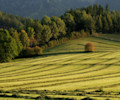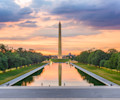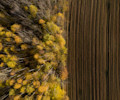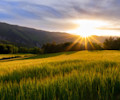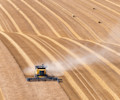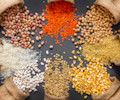While festive sales are on the rise, we consider the sustainability issues surrounding the salmon farming industry.
Salmon consumption worldwide is three times higher than it was in 1980, and demand for salmon tends to increase over the festive period. Globally, 70% of salmon are now farmed, making salmon aquaculture the fastest growing food production system in the world. The recent FAO 1.5 degrees roadmap forecasts a 75% increase in sustainable aquaculture by 2040, though “sustainable” remains to be defined.
The reality of salmon farming is more complex than the sustainability claims the industry puts forward. Producers face multiple risks associated with open-net coastal pens and feed sourcing, which are difficult to fully mitigate even when best governance, policies and practices – as they are currently understood – are in place. Several of the leading salmon producers are considered Low Risk by the Coller FAIRR Protein Producer Index, which is based on public disclosures. Yet they continue to be the subject of controversies and there is community opposition to new site developments. Several producers may acknowledge these risks by allocating more capital to new production systems, such as land-based Recirculating Aquaculture Systems (RAS), to avoid the impacts that salmon have on oceans and diseases.
Pests and Diseases Trouble Salmon’s Healthy Image
The salmon industry is under increasing civil society and media scrutiny given ongoing animal welfare issues such as overcrowding in farms, parasites and sea lice infestations, and fish swimming in polluted deoxygenated water – thereby hurting the whole industry’s projected image that salmon is a healthy protein. A 2023 investigation by Animal Equality noted several salmon welfare violations in offshore Scottish farms as animals are mishandled, improperly stunned and left to suffocate to death. 16.5 million farmed salmon died in sea pens in Scotland last year – almost double the number recorded in 2021 and triple that of 2020. Between 2013 and 2021, the estimated cost of salmon mortalities was USD $15.5 billion, with the top 10 salmon producers responsible for 100 million salmon deaths and escapes. Similarly to caged egg-laying hens, salmon welfare issues could become increasingly costly to producers beyond the mortalities as consumer awareness continues to grow, raising the possibility of tougher requirements by supermarkets and regulators.
Pollution and Feed Sourcing Are Also Major Risks to Salmon Production Growth
Environmental challenges may receive less attention from the public but nonetheless present critical risks to the salmon industry. The waters surrounding salmon farms have in many instances been found to be polluted with the waste from farmed fish and nutrients from uneaten feed. The resulting poor water quality becomes less tolerable for native species and contributes to deadly algal blooms. An over-reliance on plastic in farms, as well as the use of Acoustic Deterrent Devices, or ‘seal scarers’, also create pollution impacting wildlife populations. Imported cleaner fish – due to the sea lice infestations – and salmon escapes can also become invasive and interfere with local biodiversity.
These impacts are well publicised, making it difficult for the industry as a whole to build and maintain a social licence to operate and expand. This has emboldened regulators to be tougher. Norway has implemented a 25% “salmon tax” (initially proposed at 40%) which caused aquaculture share prices to fall by nearly 50% when it was announced in 2022. The Norwegian government faced little of the community uproar that has plagued other regulatory changes targeting the livestock sector, such as the Netherlands’ plan to reduce its animal population to control pollution. This relative lack of opposition suggests that salmon farming has yet to build the social standing that other animal farming industries traditionally have with communities where they operate.
Salmon need a protein-rich diet, which they can get through fish meal and marine ingredients that come from fish oil. However, there is a significant lack of transparency regarding how farms acquire these. This, in turn, increases the risks of Illegal, Unreported and Unregulated (IUU) fishing and human rights abuses. The reliance on wild-caught fish, discussed at length in FAIRR’s sustainable aquaculture engagement increases the risk of overfishing, especially as over 90% of wild fisheries are classified as overfished or harvested at maximal capacity. Overall, the costs of salmon farming to marine ecosystems through pollution, parasites and high fish mortality are estimated to be about USD $50 billion globally from 2013 to 2019.
Plant-Based Alternatives Are More Sustainable
While ESG challenges are difficult to abate for the aquaculture industry, plant-based alternatives offer a more immediate sustainability route, with similar health benefits. The EAT Lancet report concluded that the “most sustainable diet” is primarily plant-based and only contains “modest amounts of fish”.
From a nutritional perspective, while salmon is often cited for its high omega-3 content, this is primarily due to the algae oil from seaweed being carried through the food chain. Both can be directly consumed by humans for a more efficient – and sustainable – intake of omega-3.
Alternative seafood that mimics the aspect and taste of salmon remains small but is gaining traction. Encompassing plant-based and cultivated seafood, these products present fewer health risks, do not require the use of wild-caught fish for feed, and can contribute to the Just Transition by creating jobs and bringing seafood to landlocked areas. The alternative protein sector raised USD $2.9 billion in investments in 2022 globally, and while plant-based seafood remains less developed than other categories such as dairy, 12 start-ups raised USD $54 million that year. In Europe, plant-based seafood has seen the highest sales growth rate with 326% between 2020 and 2022.
These products are still often at the premium end of the price range, thus seeing global sales decrease since 2021 in line with other premium products including beef due to the higher cost of living. Yet, Europe and APAC saw a 24% and 43% YoY increase respectively and a 2022 GFI survey shows that investors’ appetite for alternative proteins as a whole remains strong. Out of the 60 companies assessed in the Coller FAIRR Protein Producer Index, 25 are investing in the alternative protein market, compared to only 6 in 2019.
So, while truly sustainable salmon may be difficult to source this festive season, the options are increasing for those who wish to enjoy a more sustainable Christmas dinner.
This Insights piece was updated on 01 March 2024 to include links to two additional sources, and to clarify the prevalence of issues mentioned in the text.
FAIRR insights are written by FAIRR team members and occasionally co-authored with guest contributors. The authors write in their individual capacity and do not necessarily represent the FAIRR view.

